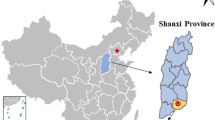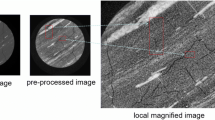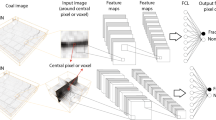Abstract
Coalbed methane (CBM) is an important unconventional fuel source, and its efficient extraction is of great significance in reducing greenhouse gas emissions, energy requirements, and coal mine safety. Liquid nitrogen (LN2) fracturing is a popular super-cryogenic waterless fracturing method used for enhancing CBM recovery processes. Understanding the behavior of coal fractures under LN2 cyclic fracturing is crucial for revealing the fracture mechanism. In this study, we applied micro-computed tomography (μCT) and the deep learning method to quantify the evolution of volume size, spatial distribution, connectivity, and thickness of 3D fractures in coal under LN2 cyclic fracturing. In addition, the spatial topological and geometric distribution of 3D fractures were further characterized by the pore network model (PNM). A coal microfracture segmentation method from a 2D U-Net model to a 3D U-Net model was proposed to segment fractures automatically and accurately with an average Dice coefficient of 0.942. The results show that LN2 treatment can effectively damage the coal sample and promote the expansion and formation of fractures. The porosity, fracture connectivity, and thickness increase with the number of LN2 cycles, and the increase in the first cycle is significantly higher than in the subsequent cycles. The PNM analysis indicates that the number and equivalent diameter of pores and throats, as well as the coordination numbers, increase with the cycles while the average throat length decreases. Furthermore, the increase in the size of fractures and the formation of large fractures would greatly reduce the P-wave velocity and weaken the uniaxial compressive strength, which decreases by 26.5% and 73.5% after four LN2 fracturing cycles, respectively. Finally, the mechanism of LN2 cyclic fracturing is discussed based on experimental results. The findings of this study provide a deeper understanding of the application of LN2 cyclic fracturing in CBM reservoir recovery.
Highlights
-
1.
The coal microstructure is precisely extracted using a combination method of μCT scanning and 3D U-Net.
-
2.
The evolution of coal 3D microstructure under LN2 cyclic fracturing is visualized and quantitatively analyzed.
-
3.
LN2 cyclic fracturing has a higher efficiency on CT slices with small initial porosity.
-
4.
The effect of fracture size on coal P-wave and mechanical properties was revealed.






















Similar content being viewed by others
Data Availability
The data that support the findings of this study are available from the corresponding author upon reasonable request.
Abbreviations
- τ :
-
Local thickness of fractures
- Ω:
-
Set of all fracture voxels
- \({\overrightarrow{p}}\) :
-
Arbitrary point within the fracture structure
- \(S({\overrightarrow{x}} ,r)\) :
-
Maximum sphere that contains the point \({\overrightarrow{p}}\)
- \({\overrightarrow{x}}\) :
-
Center of the sphere \(S({\overrightarrow{x}} ,r)\)
- r :
-
Radius of the sphere \(S({\overrightarrow{x}} ,r)\)
- P f :
-
Frost expansion force of single fracture (MPa)
- k i :
-
Volume expansion coefficient of water
- K i T :
-
Ice bulk modulus at temperature T (MPa)
- β :
-
Volume expansion coefficient of water–ice phase transition (°C−1)
- u T :
-
Freezing ratio at temperature T (%)
- ζ :
-
Water migration flux ratio
- E i T :
-
Elastic modulus of ice (MPa)
- v i T :
-
Poisson ratio of ice
- v s T :
-
Poisson ratio of coal
- G i T :
-
Shear modulus of coal (MPa)
- σ :
-
Tensile stress of micro-unit (MPa)
- E :
-
Elasticity modulus (MPa)
- ε :
-
Strain
- α :
-
Linear thermal expansion coefficient (°C−1)
- ΔT :
-
Variation of temperature (°C)
- \(\sigma^{\prime}\) :
-
Real tensile stress of micro-unit (MPa)
- \(\varepsilon^{\prime}\) :
-
Real strain
References
Akhondzadeh H, Keshavarz A, Al-Yaseri AZ, Ali M, Awan FUR, Wang X, Yang YF, Iglauer S, Lebedev M (2020) Pore-scale analysis of coal cleat network evolution through liquid nitrogen treatment: a micro-computed tomography investigation. Int J Coal Geol 219:103370. https://doi.org/10.1016/j.coal.2019.103370
Akhondzadeh H, Keshavarz A, Awan FUR, Zamani A, Iglauer S, Lebedev M (2022) Coal cleat network evolution through liquid nitrogen freeze-thaw cycling. Fuel 314:123069. https://doi.org/10.1016/j.fuel.2021.123069
Al-Kharusi AS, Blunt MJ (2007) Network extraction from sandstone and carbonate pore space images. J Pet Sci Eng 56(4):219–231. https://doi.org/10.1016/j.petrol.2006.09.003
Byun H, Kim J, Yoon D, Kang I, Song JJ (2021) A deep convolutional neural network for rock fracture image segmentation. Earth Sci Inform 14(4):1937–1951. https://doi.org/10.1007/s12145-021-00650-1
Chen LC, Zhu Y, Papandreou G, Schroff F, Adam H (2018) Encoder–decoder with atrous separable convolution for semantic image segmentation. In: Proceedings of the European conference on computer vision (ECCV). Munich, Germany, pp 801–818
Chen S, Zhang L, Zhang C, Huang M (2019) Experimental study on the seepage characteristics of bituminous coal under the conditions of liquid nitrogen fracturing. Energy Sci Eng 7(5):2138–2154. https://doi.org/10.1002/ese3.419
Chu Y, Zhang D, Liu H, Wu X, Zhai P, Sheng T (2022) Experimental study on mechanical properties, acoustic emission characteristics and energy evolution of coal samples after freezing with liquid nitrogen. Fuel 321:123955. https://doi.org/10.1016/j.fuel.2022.123955
Du M, Gao F, Cai C, Su S, Wang Z (2021) Experimental study on the damage and cracking characteristics of bedded coal subjected to liquid nitrogen cooling. Rock Mech Rock Eng 54(11):5731–5744. https://doi.org/10.1007/s00603-021-02584-y
Emanuella T, Karen SA, Sidnei P (2020) Discrimination of pores and cracks in iron ore pellets using deep learning neural networks. REM Int Eng J 73(2):197–203. https://doi.org/10.1590/0370-44672019730119
Freyer M, Ale A, Schulz RB, Zientkowska M, Ntziachristos V, Englmeier K-H (2010) Fast automatic segmentation of anatomical structures in x-ray computed tomography images to improve fluorescence molecular tomography reconstruction. JBO 15(3):36006. https://doi.org/10.1117/1.3431101
Hao DY, Tu SH, Zhang C (2020) Experimental study on the effect of moisture content on bituminous coal porosity based on 3D reconstruction of computerized tomography. Nat Resour Res 29(3):1657–1673. https://doi.org/10.1007/s11053-019-09528-y
Hildebrand TR, Rüegsegger P (2003) A new method for the model-independent assessment of thickness in three-dimensional images. J Microsc Oxf 185(1):67–75
Huang Q, Liu S, Wang G, Wu B, Zhang Y (2019a) Coalbed methane reservoir stimulation using guar-based fracturing fluid: a review. J Nat Gas Sci Eng 66:107–125. https://doi.org/10.1016/j.jngse.2019.03.027
Huang ZW, Wen HT, Wu XG, Li GH, Yang RY, Li R, Zang CH (2019b) Experimental study on cracking of high temperature granite using liquid nitrogen. J China Univ Petrol 43(2):68–76. https://doi.org/10.3969/j.issn.1673-5005.2019.02.008
Huang Z, Zhang S, Yang R, Wu X, Li R, Zhang H, Hung P (2020) A review of liquid nitrogen fracturing technology. Fuel 266:117040. https://doi.org/10.1016/j.fuel.2020.117040
Jegou S, Drozdzal M, Vazquez D, Romero A, Bengio Y (2017) The one hundred layers tiramisu: fully convolutional DenseNets for semantic segmentation. In: Proceedings of the IEEE conference on computer vision and pattern recognition workshops. Honolulu, USA, pp 11–19
Karimpouli S, Tahmasebi P, Saenger EH (2020) Coal cleat/fracture segmentation using convolutional neural networks. Nat Resour Res 29(3):1675–1685. https://doi.org/10.1007/s11053-019-09536-y
Li Z, Ren T, Li X, Qiao M, Yang X, Tan L, Nie B (2023) Multi-scale pore fractal characteristics of differently ranked coal and its impact on gas adsorption. Int J Min Sci Technol 33(4):389–401. https://doi.org/10.1016/j.ijmst.2022.12.006
Lin J, Ren T, Cheng Y, Nemcik J, Wang G (2019) Cyclic N2 injection for enhanced coal seam gas recovery: a laboratory study. Energy 188:116115. https://doi.org/10.1016/j.energy.2019.116115
Lin H, Li J, Yan M, Li S, Qin L, Zhang Y (2020) Damage caused by freeze–thaw treatment with liquid nitrogen on pore and fracture structures in a water-bearing coal mass. Energy Sci Eng 8(5):1667–1680. https://doi.org/10.1002/ese3.623
Liu QH, Huang SB, Kang YS, Pan Y, Cui XZ (2015) Numerical and theoretical studies on frost heaving pressure in a single fracture of frozen rock mass under low temperature. Chin J Geotech Eng 37(9):1572–1580. https://doi.org/10.11779/CJGE201509003
Lu F, Fu C, Zhang G, Zhang W, **e Y, Li Z (2020) Convolution neural network based on fusion parallel multiscale features for segmenting fractures in coal-rock images. J Electron Imaging 29(02):1. https://doi.org/10.1117/1.JEI.29.2.023008
Moore TA (2012) Coalbed methane: a review. Int J Coal Geol 101:36–81. https://doi.org/10.1016/j.coal.2012.05.011
Ni X, Miao J, Lv R, Lin X (2017) Quantitative 3D spatial characterization and flow simulation of coal macropores based on μCT technology. Fuel 200:199–207. https://doi.org/10.1016/j.fuel.2017.03.068
Oktay O, Schlemper J, Le Folgoc L, Lee M, Heinrich M, Misawa K, Mori K, McDonagh S, Hammerla NY, Kainz B, Glocker B, Rueckert D (2018) Attention U-Net: learning where to look for the pancreas. ar**v:1804.03999
ORS Dragonfly (2022) Object Research Systems (ORS) Inc, Montreal, Canada. https://www.theobjects.com/dragonfly. Accessed 15 May 2023
Otsu N (1979) A threshold selection method from gray-level histograms. IEEE Trans Syst Man Cybern 9(1):62–66. https://doi.org/10.1109/tsmc.1979.4310076
Pan J (2019) Status quo, prospects and policy suggestions for unconventional natural gas E&D in China. Int Pet Econ 27(2):51–59
Pan J, Mou P, Ju Y, Wang K, Zhu Q, Ge T, Yu K (2022) Micro-nano-scale pore stimulation of coalbed methane reservoirs caused by hydraulic fracturing experiments. J Pet Sci Eng 214:110512. https://doi.org/10.1016/j.petrol.2022.110512
Qin L, Zhai C, Liu S, Xu J, Yu G, Sun Y (2017) Changes in the petrophysical properties of coal subjected to liquid nitrogen freeze-thaw—a nuclear magnetic resonance investigation. Fuel 194:102–114. https://doi.org/10.1016/j.fuel.2017.01.005
Qin L, Li S, Zhai C, Lin H, Zhao P, Shi Y, Bai Y (2020) Changes in the pore structure of lignite after repeated cycles of liquid nitrogen freezing as determined by nitrogen adsorption and mercury intrusion. Fuel 267:117214. https://doi.org/10.1016/j.fuel.2020.117214
Qin L, Ma C, Li S, Lin H, Wang P, Long H, Yan D (2022a) Mechanical damage mechanism of frozen coal subjected to liquid nitrogen freezing. Fuel 309:122124. https://doi.org/10.1016/j.fuel.2021.122124
Qin L, Zhang X, Li S, Wang W, Lin S, Wang P (2022b) Fluid space reformation law of liquid nitrogen fracturing coal based on NMR T1–T2 spectra and inspiration for coalbed methane production. Fuel 324:124811. https://doi.org/10.1016/j.fuel.2022.124811
Ronneberger O, Fischer P, Brox T (2015) U-Net: convolutional networks for biomedical image segmentation. Springer International Publishing, Berlin
Rosa L, Rulli MC, Davis KF, D’Odorico P (2018) The water-energy nexus of hydraulic fracturing: a global hydrologic analysis for shale oil and gas extraction. Earths Future 6(5):745–756. https://doi.org/10.1002/2018EF000809
Rosin PL (2001) Unimodal thresholding. Pattern Recognit 34(11):2083–2096. https://doi.org/10.1016/S003-3203(00)00136-9
Salehi SSM, Erdogmus D, Gholipour A (2017) Tversky loss function for image segmentation using 3D fully convolutional deep networks. In: International workshop on machine learning in medical imaging. Quebec City, Canada, pp 379–387
Silin D, Patzek T (2006) Pore space morphology analysis using maximal inscribed spheres. Physica A 371(2):336–360. https://doi.org/10.1016/j.physa.2006.04.048
Sun HF (2017) Methods and applications of digital rock physics for complex reservoir studies. Dissertation, China University of Petroleum, Bei**g
Sun Y, Zhai C, Xu JZ, Cong YZ, Zheng YF (2021) Experimental study on pore structure evolution of coal in macroscopic, mesoscopic, and microscopic scales during liquid nitrogen cyclic cold-shock fracturing. Fuel 291:120150. https://doi.org/10.1016/j.fuel.2021.120150
Thakur P, Schatzel SJ, Aminian K (2014) Coal bed methane: from prospect to pipeline, 1st edn. Elsevier, Amsterdam
Tung PKM, Halim AY, Wang H, Rich A, Marjo C, Regenauer-Lieb K (2022) Deep-XFCT: deep learning 3D-mineral liberation analysis with micro-X-ray fluorescence and computed tomography. Energies 15(15):5326. https://doi.org/10.3390/en15155326
VanGeet M, Swennen R, Wevers M (2000) Quantitative analysis of reservoir rocks by microfocus X-ray computerised tomography. Sediment Geol 132(1–2):25–36. https://doi.org/10.1016/S0037-0738(99)00127-X
Wang K, Du F (2020) Coal-gas compound dynamic disasters in China: a review. Process Saf Environ 133:1–17. https://doi.org/10.1016/j.psep.2019.10.006
Wang L, Liu SM, Cheng YP, Yin GZ, Zhang DM, Guo PK (2017) Reservoir reconstruction technologies for coalbed methane recovery in deep and multiple seams. Int J Min Sci Technol 27(2):277–284. https://doi.org/10.1016/j.ijmst.2017.01.026
Woo B, Lee M (2021) Comparison of tissue segmentation performance between 2D U-Net and 3D U-Net on brain MR Images. In: 2021 International conference on electronics, information, and communication (ICEIC), Jeju, Korea (South), pp 1–4
Wu H, Zhou YF, Yao YB, Wu KJ (2019a) Imaged based fractal characterization of micro-fracture structure in coal. Fuel 239:53–62. https://doi.org/10.1016/j.fuel.2018.10.117
Wu X, Huang Z, Zhang S, Cheng Z, Li R, Song H, Wen H, Huang P (2019b) Damage analysis of high-temperature rocks subjected to LN2 thermal shock. Rock Mech Rock Eng 52(8):2585–2603. https://doi.org/10.1007/s00603-018-1711-y
Wu Y, Tao J, Wang J, Zhang Y, Peng S (2021) Experimental investigation of shale breakdown pressure under liquid nitrogen pre-conditioning before nitrogen fracturing. Int J Min Sci Technol 31(4):611–620. https://doi.org/10.1016/j.ijmst.2021.05.006
Xu J, Zhai C, Qin L (2017) Mechanism and application of pulse hydraulic fracturing in improving drainage of coalbed methane. J Nat Gas Sci Eng 40:79–90. https://doi.org/10.1016/j.jngse.2017.02.012
Yan H, Tian L, Feng R, Mitri H, Chen J, He K, Zhang Y, Yang S, Xu Z (2020) Liquid nitrogen waterless fracking for the environmental protection of arid areas during unconventional resource extraction. Sci Total Environ 721:137719. https://doi.org/10.1016/j.scitotenv.2020.137719
Yin G, Shang D, Li M, Huang J, Gong T, Song Z, Deng B, Liu C, **e Z (2018) Permeability evolution and mesoscopic cracking behaviors of liquid nitrogen cryogenic freeze fracturing in low permeable and heterogeneous coal. Powder Technol 325:234–246. https://doi.org/10.1016/j.powtec.2017.10.058
Yuan B, Wood DA, Yu W (2015) Virtual special issue: stimulation and hydraulic fracturing technology in natural gas reservoirs: theory and case studies (2012–2015). J Nat Gas Sci Eng 26:1508–1509. https://doi.org/10.1016/j.jngse.2015.09.002
Zeiler MD (2012) ADADELTA: an adaptive learning rate method. Computer. https://doi.org/10.48550/ar**v.1212.5701
Zhang Y, Lebedev M, Al-Yaseri A, Yu H, Xu X, Iglauer S (2018) Characterization of nanoscale rockmechanical properties and microstructures of a Chinese sub-bituminous coal. J Nat Gas Sci Eng 52:106–116. https://doi.org/10.1016/j.jngse.2018.01.037
Zhang L, Chen S, Zhang C, Fang XQ, Li S (2020) The characterization of bituminous coal microstructure and permeability by liquid nitrogen fracturing based on mu CT technology. Fuel 262:116635. https://doi.org/10.1016/j.fuel.2019.116635
Zhao Y, Sun Y, Liu S, Wang K, Jiang Y (2017) Pore structure characterization of coal by NMR cryoporometry. Fuel 190:359–369. https://doi.org/10.1016/j.fuel.2016.10.121
Zhao D, Wang Q, Li D, Feng Z (2018) Experimental study on infiltration and freeze–thaw damage of water-bearing coal samples with cryogenic liquid nitrogen. J Nat Gas Sci Eng 60:24–31. https://doi.org/10.1016/j.jngse.2018.09.027
Zheng Y, Zhai C, Chen A, Yu X, Xu J, Sun Y, Cong Y, Tang W, Zhu X, Li Y (2023) Microstructure evolution of bituminite and anthracite modified by different fracturing fluids. Energy 263:125732. https://doi.org/10.1016/j.energy.2022.125732
Zhou HW, Zhong JC, Ren WG, Wang XY, Yi HY (2018a) Characterization of pore-fracture networks and their evolution at various measurement scales in coal samples using X-ray μCT and a fractal method. Int J Coal Geol 189:35–49. https://doi.org/10.1016/j.coal.2018.02.007
Zhou Z, Rahman Siddiquee MM, Tajbakhsh N, Liang J (2018b) UNet++: a nested U-Net architecture for medical image segmentation. In: International workshop on deep learning in medical image analysis, international workshop on multimodal learning for clinical decision support. Springer, Cham, pp 3–11
Zhu A, Liu J, Ding G, Wu Z, Shi X, Zeng Y (2022) Experimental investigation on permeability, meso-damage and fractal characteristics of limestone caprock under THM coupling based on μCT technology. J Pet Sci Eng 212:110197. https://doi.org/10.1016/j.petrol.2022.110197
Zou Q, Lin B (2018) Fluid–solid coupling characteristics of gas-bearing coal subjected to hydraulic slotting: an experimental investigation. Energy Fuels 32(2):1047–1060. https://doi.org/10.1021/acs.energyfuels.7b02358
Funding
This work was supported by the National Natural Science Foundation of China (Grant no. 51934007, 51874292), the Fundamental Research Funds for the Central Universities (Grant no. 2022XSCX20), and the Postgraduate Research and Practice Innovation Program of Jiangsu Province (Grant no. KYCX21_2379).
Author information
Authors and Affiliations
Corresponding authors
Ethics declarations
Conflict of Interest
The authors declare that there are no conflicts of interest regarding the publication of this paper.
Additional information
Publisher's Note
Springer Nature remains neutral with regard to jurisdictional claims in published maps and institutional affiliations.
Rights and permissions
Springer Nature or its licensor (e.g. a society or other partner) holds exclusive rights to this article under a publishing agreement with the author(s) or other rightsholder(s); author self-archiving of the accepted manuscript version of this article is solely governed by the terms of such publishing agreement and applicable law.
About this article
Cite this article
Chen, S., Dou, L., Cai, W. et al. Evolution of Coal Microfracture by Cyclic Fracturing of Liquid Nitrogen Based on μCT and Convolutional Neural Networks. Rock Mech Rock Eng 57, 2103–2124 (2024). https://doi.org/10.1007/s00603-023-03649-w
Received:
Accepted:
Published:
Issue Date:
DOI: https://doi.org/10.1007/s00603-023-03649-w




